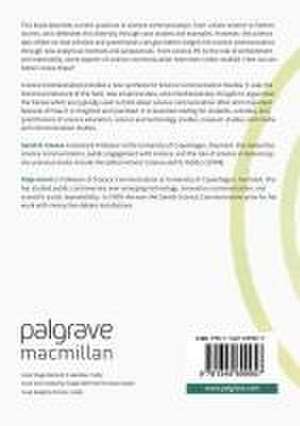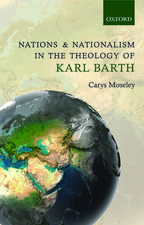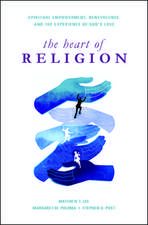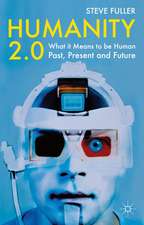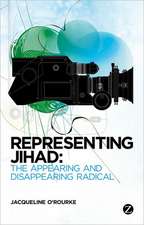Science Communication: Culture, Identity and Citizenship
Autor Sarah R. Davies, Maja Horsten Limba Engleză Paperback – oct 2016
This book describes current practices in science communication, from citizen science to Twitter storms, and celebrates this diversity through case studies and examples. However, the authors also reflect on how scholars and practitioners can gain better insight into science communication through new analytical methods and perspectives. From science PR to the role of embodiment and materiality, some aspects of science communication have been under-studied. How can we better notice these?
Science Communication provides a new synthesis for Science Communication Studies. It uses the historical literature of the field, new empirical data, and interdisciplinary thought to argue that the frames which are typically used to think about science communication often omit important features of how it is imagined and practised. It is essential reading for students, scholars, and practitioners of science education, science and technology studies, museum studies, and media and communication studies.
| Toate formatele și edițiile | Preț | Express |
|---|---|---|
| Paperback (1) | 942.67 lei 6-8 săpt. | |
| Palgrave Macmillan UK – oct 2016 | 942.67 lei 6-8 săpt. | |
| Hardback (1) | 1090.10 lei 6-8 săpt. | |
| Palgrave Macmillan UK – 19 dec 2016 | 1090.10 lei 6-8 săpt. |
Preț: 942.67 lei
Preț vechi: 1149.59 lei
-18% Nou
Puncte Express: 1414
Preț estimativ în valută:
180.38€ • 188.33$ • 149.29£
180.38€ • 188.33$ • 149.29£
Carte tipărită la comandă
Livrare economică 04-18 aprilie
Preluare comenzi: 021 569.72.76
Specificații
ISBN-13: 9781349699957
ISBN-10: 1349699950
Pagini: 248
Ilustrații: VIII, 266 p. 1 illus. in color.
Dimensiuni: 148 x 210 mm
Greutate: 0.36 kg
Ediția:1st ed. 2016
Editura: Palgrave Macmillan UK
Colecția Palgrave Macmillan
Locul publicării:London, United Kingdom
ISBN-10: 1349699950
Pagini: 248
Ilustrații: VIII, 266 p. 1 illus. in color.
Dimensiuni: 148 x 210 mm
Greutate: 0.36 kg
Ediția:1st ed. 2016
Editura: Palgrave Macmillan UK
Colecția Palgrave Macmillan
Locul publicării:London, United Kingdom
Descriere
Science communication activities such as public events and lectures, science festivals, and media coverage of science have proliferated over the last three decades, in the UK, US and across Europe. Science Communication Studies is now a discipline in its own right, with its own conferences, journals, and postgraduate courses (some 27 in the UK alone). Research in this area has been highly interdisciplinary, drawing on thinking from Science and Technology Studies (STS), Media and Communication Studies, and Museum Studies. However, thus far there have been limited efforts to draw this work together to provide an overarching account of where research into science communication has come from, and in what directions it should be going.
Cuprins
Chapter 1. Introduction.- Chapter 2. Histories.- Chapter 3. Identities.- Chapter 4. The Changing Nature of Science Communication.- Chapter 5. The Changing Nature of Science.- Chapter 6. Futures.- Chapter 7. Images, Spaces and Emotions.- Chapter 8. Citizenship.- Chapter 9. Deficit and Dialogue.
Recenzii
“It explores the role of capitalism in this context, the relevance of ecology, and more. It reminds readers that scientists publicize their research to persuade funding agencies rather than for the intrinsic worth of the science. … This is a relevant, readable, informative book … . Summing Up: Highly recommended. Upper-division undergraduates through faculty.” (V. V. Raman, Choice, Vol. 54 (10), June, 2017)
Notă biografică
Sarah R. Davies is Assistant Professor at the University of Copenhagen, Denmark. She researches science communication, public engagement with science, and the role of science in democracy. Her previous books include the edited volume Science and its Publics (2008).
Maja Horst is Professor of Science Communication at University of Copenhagen, Denmark. She has studied public controversies over emerging technology, innovation communication, and scientific social responsibility. In 2009 she won the Danish Science Communication prize for her work with interactive debate installations.
Textul de pe ultima copertă
This book describes current practices in science communication, from citizen science to Twitter storms, and celebrates this diversity through case studies and examples. However, the authors also reflect on how scholars and practitioners can gain better insight into science communication through new analytical methods and perspectives. From science PR to the role of embodiment and materiality, some aspects of science communication have been under-studied. How can we better notice these?
Science Communication provides a new synthesis for Science Communication Studies. It uses the historical literature of the field, new empirical data, and interdisciplinary thought to argue that the frames which are typically used to think about science communication often omit important features of how it is imagined and practised. It is essential reading for students, scholars, and practitioners of science education, science and technology studies, museum studies, and media and communication studies.
Caracteristici
Encourages discussion about the effectiveness of science communication
Offers a synthesis of current research in Science Communication Studies and offers new directions for research
Draws on examples from disciplines including science education, STS, museum studies, and media and communication studies.
Offers a synthesis of current research in Science Communication Studies and offers new directions for research
Draws on examples from disciplines including science education, STS, museum studies, and media and communication studies.
